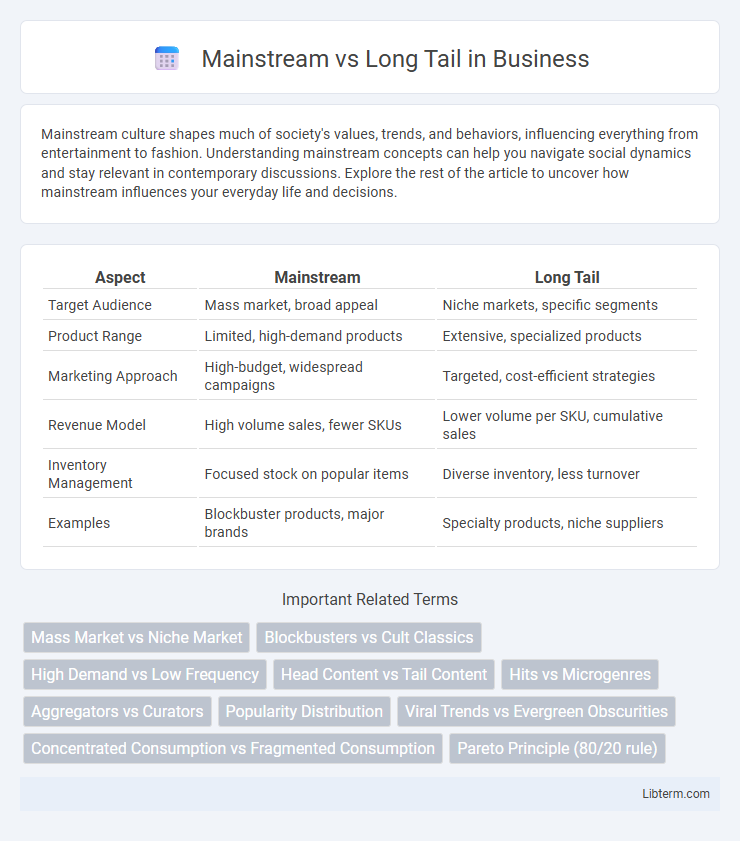Mainstream culture shapes much of society's values, trends, and behaviors, influencing everything from entertainment to fashion. Understanding mainstream concepts can help you navigate social dynamics and stay relevant in contemporary discussions. Explore the rest of the article to uncover how mainstream influences your everyday life and decisions.
Table of Comparison
| Aspect | Mainstream | Long Tail |
|---|---|---|
| Target Audience | Mass market, broad appeal | Niche markets, specific segments |
| Product Range | Limited, high-demand products | Extensive, specialized products |
| Marketing Approach | High-budget, widespread campaigns | Targeted, cost-efficient strategies |
| Revenue Model | High volume sales, fewer SKUs | Lower volume per SKU, cumulative sales |
| Inventory Management | Focused stock on popular items | Diverse inventory, less turnover |
| Examples | Blockbuster products, major brands | Specialty products, niche suppliers |
Understanding Mainstream and Long Tail Concepts
Mainstream refers to popular products, services, or content that appeal to a broad audience and generate high demand, often characterized by mass-market appeal and significant sales volume. Long Tail describes a business strategy focusing on niche markets with a large number of unique, less popular items collectively generating substantial revenue over time. Understanding these concepts enables businesses to balance inventory, marketing efforts, and customer targeting by leveraging both high-demand mainstream products and diverse long-tail offerings.
Key Differences Between Mainstream and Long Tail
Mainstream markets focus on high-demand products that appeal to a broad audience, generating significant sales volume and brand recognition. Long tail markets target niche products with lower demand but collectively achieve substantial revenue through a wide variety of options and specialized customer interests. The primary difference lies in market strategy: mainstream emphasizes mass appeal and efficiency, while long tail leverages diversity and customization to capture smaller, specific segments.
Historical Evolution of Mainstream Culture
Mainstream culture has historically evolved through mass media platforms such as radio, television, and cinema, which centralized content dissemination and shaped widely accepted norms and values. This cultural evolution was driven by economic forces favoring mass appeal to maximize audience reach and advertising revenue. Over time, technological advancements, especially the internet, disrupted this centralized model, allowing long tail niches to flourish alongside mainstream culture by catering to diverse, specialized interests.
The Rise of the Long Tail in the Digital Era
The rise of the Long Tail in the digital era is driven by platforms like Amazon, Netflix, and Spotify, which leverage vast inventories and user data to cater to niche markets and personalized preferences. Unlike mainstream hits that target broad audiences, the Long Tail thrives on aggregating numerous niche products, generating cumulative revenue that rivals or exceeds popular blockbusters. Digital distribution drastically reduces costs and barriers, enabling creators and consumers to connect through diverse content, fueling exponential growth in long-tail economies.
Advantages of Mainstream Content
Mainstream content captures a broad audience by appealing to popular tastes, ensuring higher visibility and engagement across multiple platforms. This type of content benefits from established trends and mass appeal, leading to increased advertising revenue and better brand recognition. Producing mainstream content often results in faster returns on investment due to its widespread reach and demand.
Benefits of Long Tail Niches
Long tail niches offer unique benefits by targeting highly specific audiences with less competition, enabling businesses to achieve higher conversion rates and customer loyalty. These niches allow for more personalized marketing strategies and product offerings, which increase relevance and customer satisfaction. Embracing long tail markets can lead to diversified revenue streams and sustainable growth by tapping into underserved or emerging segments.
Challenges Facing Mainstream Markets
Mainstream markets face intense competition due to the high density of established brands vying for consumer attention, leading to significant marketing and pricing pressure. Consumer preferences in mainstream markets often shift rapidly, requiring companies to continuously innovate and adapt to maintain relevance. Additionally, barriers to entry and saturation make it difficult for new products to differentiate, resulting in diminished profit margins and increased risk.
Obstacles in the Long Tail Landscape
Obstacles in the long tail landscape include limited visibility and discoverability due to niche market fragmentation, which hinders reaching broader audiences compared to mainstream markets. Monetization challenges arise from lower demand and higher marketing costs per unit, affecting profitability for long tail products. Data analytics limitations and scalability issues further complicate optimizing inventory and content strategies in long tail segments.
Impact on Consumer Behavior
Mainstream products attract broad consumer bases by meeting common needs, resulting in predictable purchasing patterns and high sales volume. Long tail markets emphasize niche products, enabling consumers to explore specialized interests and fostering personalized buying experiences. This shift toward long tail offerings diversifies consumer behavior, increases demand for variety, and influences how businesses tailor marketing strategies.
Future Trends: Mainstream vs Long Tail
Future trends indicate a growing shift toward long tail markets driven by digital platforms enabling niche content and personalized experiences, expanding customer reach beyond mainstream offerings. Advances in AI and data analytics enhance long tail product discovery, optimizing inventory and marketing strategies for diverse consumer preferences. Mainstream markets will continue to dominate high-volume sales, but long tail segments will capture increasing value through fragmentation and targeted engagement.
Mainstream Infographic

 libterm.com
libterm.com